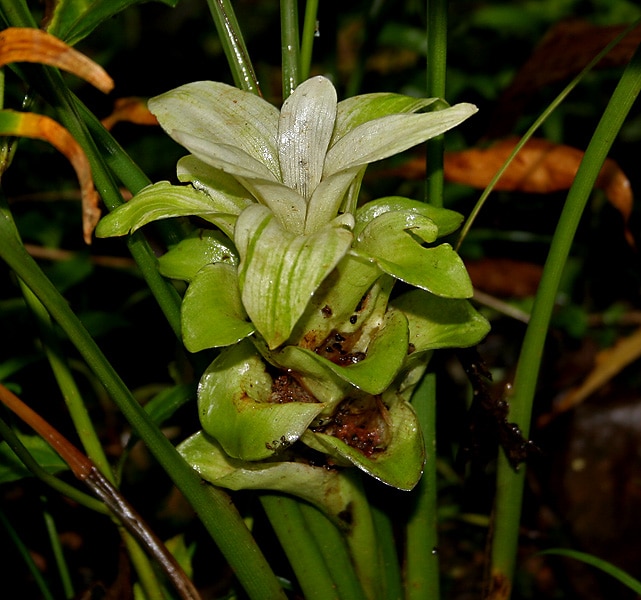Turmeric:
What is it?, history, cultivation, nutritional value, uses, recipes and more...
Turmeric, also known as turmeric root or turmeric powder, is a root native to India that stands out for its therapeutic benefits, especially for the liver and skin. In Peru, it grows in the lowland jungle, in clayey-silty (beach) soils that have been fertilized during the river’s rising stage.
Índice
What is Turmeric?
Turmeric, also known as turmeric root or turmeric powder, is a perennial herbaceous plant native to southwestern India. It grows to approximately one meter in height and has oblong palmate tuberous roots or rhizomes that are intensely yellow-orange in color and highly aromatic. Its leaves are green, emerge from the root, and are wide, lanceolate, and arranged in two rows. They measure about 50 centimeters in length and have a long petiole, ranging from 50 to 115 cm long. The flowers are hermaphroditic, yellow in color, and develop in groups of three to five surrounded by green bracts, each with three petals. The fruit is capsule-shaped and divided into three compartments. Inside, which is of intense orange color, there is a browning ring with reddish-brown areas. Turmeric has a unique smell and taste, slightly bitter, aromatic, and warm.
History of Turmeric
Turmeric is mentioned in the Atharvaveda (a sacred Hindu text) dating back to around 6000 BC, where it was recommended for treating jaundice and leprosy.
Its properties were used in India between 610 BC and 320 BC, during which it was used as a dye for wool due to its intense yellow-orange color. This use has continued throughout history.
It is believed that the Assyrian civilization, around 2600 BC, used it as a pigment and included it in their color palette. Its properties as a food coloring agent were also discovered, and it began to be used to dye cheese and yogurt. In other cases, it was added to certain foods as a preservative.
Furthermore, it was adopted by Indian cuisine as a coloring and flavoring agent and is a part of the popular Indian dish, curry.
Ayurvedic medicine recommended, and still recommends, turmeric for beauty care, culinary use, and therapeutic purposes. It was also adopted by Chinese medicine, and even Buddhist monks used it as a dye to color their traditional robes.
Despite its undeniable popularity in the East, turmeric did not reach the Western world until relatively recently. There is little evidence of its use in Europe. For example, Marco Polo (1280) claimed to have found a plant that had “all the qualities of saffron, but in a root.”
It was in the mid-20th century that turmeric finally began to gain popularity in the Western world. Nowadays, the Western industry studies it, verifies its properties, and uses it in beauty products, medicines, visual arts, and food.

Common Name of Turmeric
| Cuba | Polluelo, azafrán cimarrón; yuquilla |
| Puerto Rico | Turmérico, jengibrillo |
| Peru, Bolivia | palillo cholón, palillo chuncho, guisador, palillo |
| English | Turmeric, curcuma, Indian arrow root |
| French | Curcuma, safran des Indes |
| Other names | Azafrán de la India, cúrcuma de la India, jengibre de dorar |
Scientific Name of Turmeric
Cúrcuma longa
Taxonomy of Turmeric
| Kingdom | Plantae |
| División | Magnoliophyta |
| Class | Liliopsida |
| Subclass | Zingiberidae |
| Order | Zingiberales |
| Family | Zingiberaceae |
| Genus | Cúrcuma |
| Species | Cúrcuma longa |
Synonyms of Turmeric
Amomum curcuma Jacq.
Curcuma brog Valeton
Curcuma domestica Valeton
Curcuma euchroma Valeton
Curcuma ochrorhiza Valeton
Curcuma soloensis Valeton
Curcuma tinctoria Guibourt
Kua domestica Medik.
Stissera curcuma Giseke
Stissera curcuma Raeusch.
Etymology of Turmeric
The word “turmeric” comes from the Arabic word كُرْكُم, kurkum, which means “saffron.”
Cultivation, Distribution, and Habitat of Turmeric
- Habitat
- Distribution
- Cultivation
Habitat of Turmeric
This plant is mainly found from Polynesia and Micronesia to Southeast Asia.
It is cultivated for its rhizomes, which are used as a spice, and it adapts well to warm and humid areas.
Its cultivation is not demanding in terms of temperature. It requires temperatures between 20°C and 30°C, rainfall between 1500 and 2000 mm per cycle, and can be grown from 0 to 1500 meters above sea level.
The optimal soils for its production are loamy, deep, and well-drained soils that allow proper development of the rhizomes and have high organic matter content. Fertile soils with good natural drainage and free from stones, tree roots, or any other obstacle that may affect the growth of the rhizomes are ideal for its cultivation.
The optimal pH for turmeric ranges from 5 to 6, and the planting distance between these plants can be between 30 to 40 cm.
Distribution of Turmeric
Turmeric is a crop that is spreading worldwide, found in more than 70 countries. It is important to note that 92% of its production was in Bolivia and Peru in 2008, while the remaining 8% was mainly in the United States, Ecuador, Argentina, and Canada.
The main producing countries are Argentina, Bolivia, Ecuador, the United States, Chile, Colombia, and Peru, although its cultivation is spreading to various countries in Europe and Asia, with high levels of yield.
The cultivation of turmeric is expanding, and it is now being produced in more than 70 countries, including France, England, Sweden, Denmark, the Netherlands, and Italy. It is also being successfully developed in Kenya, India, and the United States.
Production Regions: In the Andes of Argentina, Bolivia, Chile, Colombia, Ecuador, and Peru.
In Peru, turmeric is grown in 19 out of the 24 departments; however, the largest proportion of national production has been concentrated in the Puno region since statistical records have been kept.
In the face of the challenge of increasing the production of quality food to feed the world's population in the context of climate change, turmeric is an alternative for countries experiencing food insecurity.
Turmeric Cultivation
Sunlight Requirement: It exhibits various photoperiods, from short-day requirements for flowering near the equator to insensitivity to light conditions for its development in Chile.
Precipitation: Ranges from 300 to 1,000 mm, with rainfall conditions varying depending on the species and/or country of origin. Southern Chile varieties require significant rainfall, while those from the highlands require very little. In general, it grows well with a good distribution of rain during its growth and development, and it can withstand dry conditions, especially during maturation and harvesting.
Altitude: It grows from sea level in Chile and Peru up to 4,000 m in the Andes, but it generally thrives between 2,500 and 4,000 m above sea level.
Low Temperatures: It tolerates a wide range of climates and is not affected by cold temperatures (-1°C). However, the plant's flowers are sensitive to cold, so mid-season frosts in the Andes can destroy the crop.
High Temperatures: The plant tolerates temperatures over 35°C but does not thrive.
Soil Types: It can grow in a wide variety of soils with a pH ranging from 6 to 8.5.
Management Techniques: In the Andes, it is usually broadcasted directly onto the soil. Sometimes it is sown in narrow, shallow rows. The seedbed must be well-prepared and well-drained since the seeds can easily die due to waterlogging. The plant grows rapidly, with a growth period ranging from 90 to 120 days, depending on the varieties planted and the temperature. Mechanized production is becoming very successful in South America. Machinery used for grains and oilseeds can be used for quinoa with minor or no modifications.
Limitations and Diseases: Pests or diseases do not cause significant losses. The main problem is weeds, which grow near the crop.
Harvest: It has extremely variable maturity periods, which make mechanization difficult. That is why harvesting has been done by hand by farmers for many years, and machinery is rarely used. The productivity is approximately 3,000 kg/ha, and sometimes yields reach up to 5,000 kg/ha, comparable to wheat harvest in the Andean region. When harvesting the seeds, they are first threshed, then ventilated to remove the husk, and finally carefully dried since they must be completely dry when stored to prevent rapid germination. The quinoa seeds must be processed to remove the bitter saponins. In home settings, this is done through soaking, washing, and rubbing the seeds. Commercially, mechanical grinding or combined washing and grinding are the most common methods.
Geographical Distribution of Turmeric

Huánuco, San Martín, Cuzco, Ayacucho, Junín, Amazonas
Year-round availability of Turmeric
- There is a harvest all year round. It begins 7 months after planting.
Varieties of Turmeric
Two main types of turmeric are distinguished:
-
Long turmeric (Curcuma longa)
-
Round turmeric (Curcuma rotunda)
Nutritional Value of Turmeric
Turmeric is attributed with various nutritional properties. Its key compounds are curcuminoids and curcumins, which have antioxidant and anti-inflammatory effects. It also contains dietary fiber, vitamins C, E, and K, niacin, sodium, calcium, potassium, copper, magnesium, iron, zinc, and essential oils.
Additionally, it stimulates the immune system, can be used to treat arthritis pain, improves bile flow for better digestion, and has anti-tumor, bactericidal, antiviral, and antiseptic properties.
Health Benefits of Turmeric
Turmeric has antioxidant and anti-inflammatory properties and is low in calories and fats.
Contraindications or Side Effects
One of the recognized problems related to the consumption of turmeric is that it inhibits the proper absorption of iron, and it is believed that it could have undesired effects in individuals under 18 years of age. For this reason, it is not recommended for those who have difficulty absorbing that mineral or suffer from anemia.
It is also not advisable for pregnant and lactating women as the substance may be passed on to the baby through breast milk, and the consequences are unknown.
Another well-known contraindication is that it reduces blood clotting, so its consumption is contraindicated after surgery or significant blood loss.
Since turmeric contains oxalates, there is a risk of kidney stone formation. It is also not suitable for diabetics because it lowers blood sugar, which makes it incompatible with their medications.
Furthermore, it is presumed that intake may reduce testosterone levels and slow down sperm motility.
| 10 Porciones por Kilogramo | |
| Tamaño de porción | 100g |
| Cantidad por porción Calorías |
434 |
| Cantidad por 100g | |
| Energía | 1,814 kJ |
| Grasa Total | 12.7 g |
| Sodio | ● |
| Carbohidratos totales | 74.9 g |
| Carbohidratos disponibles | 73.8 g |
| Fibra Dietaria | 1.1 g |
| Proteínas | 6.0 g |
| Calcio | 22 mg |
| Fósforo | 665 mg |
| Zinc | 0.64 mg |
| Hierro | 0.60 mg |
| Potasio | ● |
| Agua | 4.8 g |
| Cenizas | 1.6 g |
| Vitamina A | 0 μg |
| Tiamina (B1) | 0.04 mg |
| Riboflavina (B2) | 0.04 mg |
| Niacina (B3) | 0.50 mg |
| Vitamina C | 0.00 mg |
| Acido Fólico (B9) | ● |
| β-Caroteno | ● |
| Fuente: Tablas peruanas de composición de alimentos – Centro Nacional de Alimentación y Nutrición – Ministerio de Salud – Perú | |
Derived Products and Forms of Turmeric Consumption
Uses of Turmeric
The main uses of turmeric are as a coloring agent and as a culinary ingredient. It also has significant medicinal properties and is used in the cosmetic industry.
- Culinary
- Medicinal
- Industrial
- Ritual
Culinary Use of Turmeric
Turmeric is one of the ingredients in Indian cuisine, where it is used in the famous curry, providing a characteristic intense yellow color and flavor.
It is used in various parts of the world as a food coloring agent for rice, meat, and various dishes. It is the component that gives the characteristic yellow color to American prepared mustard.
In some Spanish-speaking countries, such as Peru, it is known as "palillo" and is a widely used seasoning in traditional cooking, available in both root and powder form.
Turmeric is also a common ingredient in juices, smoothies, and infusions.
Medicinal Use of Turmeric
Among its main health benefits are:
- Relieves stomach discomfort
- Treats liver disorders
- Helps treat cancer
- Has powerful anti-inflammatory properties
- Protects against cardiovascular diseases
- Acts as a natural antidepressant
Industrial Use of Turmeric
Turmeric extract is used as a food coloring agent in two forms: as turmeric (crude extract), classified with the EU food code E100ii, showing a yellow color and extracted from the plant's root; and as curcumin (purified or refined state). It is used for dyeing cotton, wool, silk, leather, paper, lacquers, varnishes, waxes, dyes, etc.
Additionally, it is also used in the creation of cosmetic products, sunscreens, and, in India, as a hair fixative.
There is also turmeric-impregnated paper used in boron detection.
Ritual Use of Turmeric
Turmeric in India is associated with various rituals of deep and ancient significance. Turmeric is considered a symbol of health and prosperity, as well as a physical and spiritual purifier. It is customary for women to mark their forehead with a red, black, or golden circle using a powder that includes turmeric as one of its ingredients, symbolizing virtue, purity, religious observance, and worship of the divinity Shakti, the primordial energy of the Universe. These symbols represent a third eye and are known as bindi for women and tilaka or tikka for men.
In some Asian countries, especially India, couples celebrate the Haldi ritual, in which women prepare a mixture of turmeric powder with rose water or warm water to form a paste that is left to rest. Then, the guests visit the bride or groom with containers of turmeric to be applied on their faces, neckline, feet, and hands to ensure they enjoy the evening, ward off the evil eye, and eliminate negative energies, which should not exist on the day of the ceremony.



